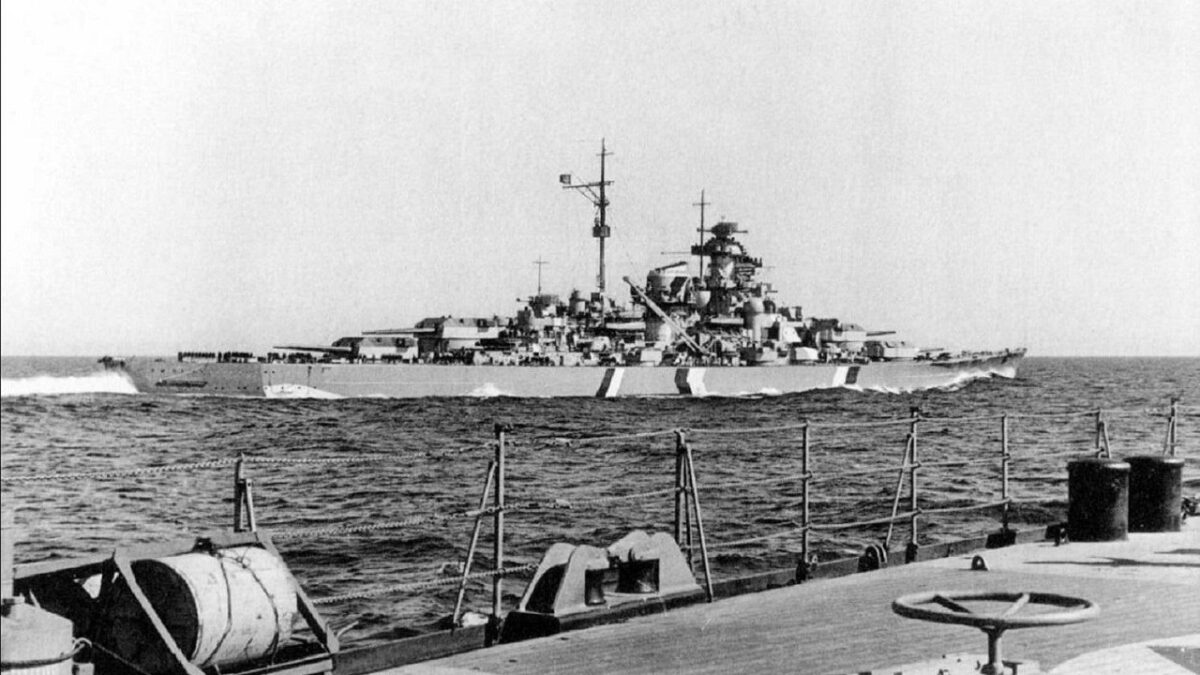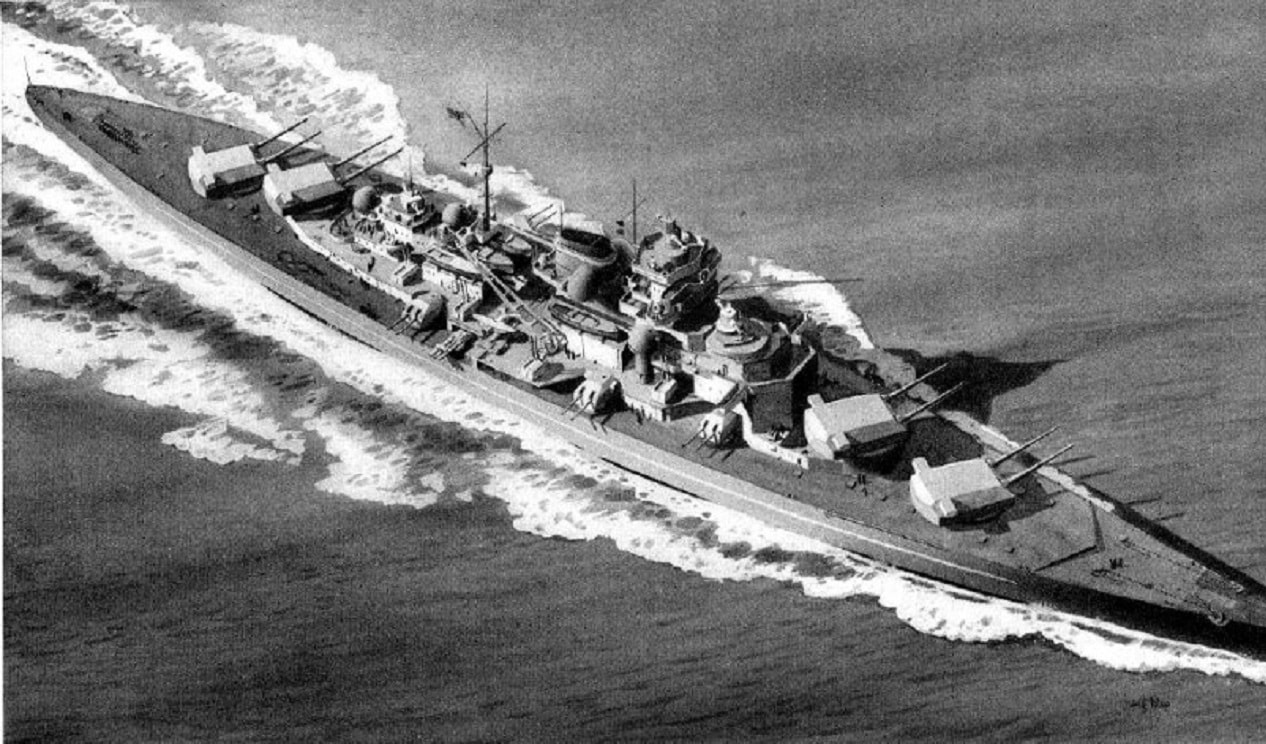During the Second World War, the United States and Great Britain were both ultimately successful against the battleships of their Axis adversaries, the Imperial Japan Navy and Nazi German Kriegsmarine respectively. The difference was in the approach.
Whilst the U.S. Navy did indeed sink more than their fair share of battleships – including the all-time biggest of the bunch: Yamato and Musashi – the fact remains that the carrier-borne aircraft became the dominant weapon of the Pacific Theatre of WWII, ergo enemy aircraft carriers were the main concentration of U.S. naval targeting efforts. By contrast, Britain’s Royal Navy (RN) and Air Force (RAF) went truly all-out in their efforts to hunt down and kill Hitler’s battlewagons.
The most epic story of these battleship hunts was, of course, the Bismarck, immortalized in song and cinema alike. The hunt for the pocket battleship Graf Spee was also pretty famous, being the first such battleship kill of the war – in the first calendar year of the war no less – and also inspiring a movie. But the German battleship sinking that was the most time-consuming on the Brits’ part was that of the Tirpitz.
Tirpitz Early History and Specifications
Tirpitz was indeed a sister ship to the Bismarck. Named for Imperial German Großadmiral (“Grand Admiral”) Alfred von Tirpitz, (1849-1930), she was laid down in the port town of Wilhelmshaven on November 2, 1936, launched on April 1, 1939, and commissioned on February 25, 1941.

Specifications of the warship included a fully-laden displacement of 52,600 tons, a hull length of 823 feet 6 inches, a beam width of 118 feet 1 inch, and a draft of 30 feet 6 inches, with a max speed of 30 knots and a crew complement of 103 commissioned officers plus 1,962 enlisted seamen. Primary armament consisted of eight 15-inch main guns, backed up by a secondary battery of twelve 5.9-inch guns, sixteen 4.1-inch guns, a whopping fifty-eight 2-centimeter antiaircraft guns, and eight 21-inch torpedo tubes.
It didn’t take long for Tirpitz’s existence to cause consternation to the British Admiralty. But it turned out that her proactive combat history was fairly stunted. Her only offensive action was during Operation Zitronella (“Lemon Flavor”) aka Unternehmen Sizilien (“Operation Sicily”), on September 8, 1943. During this raid on the Norwegian archipelago of Spitzbergen, along with battlecruiser Scharnhorst and nine destroyers, the fleet bombarded Allied-occupied settlements, resulting in six Norwegians KIA.
The Chase, the Corralling, and the Killing
From there, the embattled battleship was hounded by seemingly never-ending attacks by the RN and RAF, via mini-submarines and warplanes alike. It was the mini-submarines that inflicted the first significant damage on the Tirpitz, via a daring operation known as Operation Source that took place from September 20-22 1943; these attacks left the battlewagon crippled within the confines of the Norwegian harbor of Kåfjord, Alta.
From there, the ordeal of the Tirpitz would drag on for another 14 months. Finally, on November 12, 1944, specially-modified Avro Lancaster heavy bombers, carrying the 12,000-lb. (6-ton) “Tall Boy” bomb (which in turn would spawn the even more gargantuan 22,000-lb. “Grand Slam” earthquake bomb), finished the job. As described by the Bomber Command Museum of Canada info page:
“[A] great yellow flash burst on the foredeck and the Tirpitz was seen to tremble as it was hit by at least two Tallboys. A column of steam and smoke shot up to about 300 feet and within a few minutes the ship had started to list badly. It then suffered a tremendous explosion as the ammunition stores magazine went up. She rolled over to port and capsized. About 10 minutes after the first bomb struck, the Tirpitz had completely turned turtle with only the hull visible from the air. Approximately 1000 of her crew were killed. None of the attacking aircraft were significantly damaged and all returned safely to base … With the sinking of the Tirpitz, Hitler lost the last influential ship of his surface battle fleet and this marked the end of Germany’s naval war in northern waters.”
Where Is She Now?
Out of all the WWII shipwrecks that I’ve researched, I’d never read about any of these old maritime carcasses causing ongoing environmental damage … until now. In an article from April 2018 in Popular Mechanics titled “How the Nazis’ Largest Battleship Is Still Affecting Norway Today,” staff writer David Grossman wrote the following:
“The ship’s crew would chop down trees and place them aboard the Tirpitz to try to camouflage it and then, as discussed in a new German-American-Norwegian study, released chlorosulphuric acid to create an artificial fog to further mask its location … Claudia Hartl, from the Johannes Gutenberg University in Mainz, Germany … noticed something odd: The older trees had no growth rings … Looking at the war records, Hartl’s trees line up with the Tripitz’s locations … But while the Tirpitz is long gone, the environmental damage remains.”
Hmmm, since Greta Thunberg is from a neighboring Scandinavian country, maybe she could start a Tirpitz awareness campaign. Heck, maybe she could raise enough money to raise and re-float the battleship, and thus become a real-life female version of Dirk Pitt (the protagonist who raised the Titanic in Clive Cussler’s most famous bestselling novel).
Sarcasm aside, for anybody who’d like to indulge their curiosity about the Tirpitz in a more “hands-on” manner but lacks either the time and/or funds and/or desire to book a vacation trip to Norway, you’ve always got the option of buying and building a plastic model of the ship. (I myself went this route way back in 1987). On the other hand, if you are able to make it to Norway but not to the actual fjord where her corpse still lies, you have the option of visiting the Tirpitz Museum located in Kåfjord outside the city of Alta in Finnmark County; the museum is currently slated to reopen in June 2024, but according to the TripAdvisor listing, “Out of season we open on request for groups or other special occasions.”
Christian D. Orr is a former Air Force Security Forces officer, Federal law enforcement officer, and private military contractor (with assignments worked in Iraq, the United Arab Emirates, Kosovo, Japan, Germany, and the Pentagon). Chris holds a B.A. in International Relations from the University of Southern California (USC) and an M.A. in Intelligence Studies (concentration in Terrorism Studies) from American Military University (AMU). He has also been published in The Daily Torch and The Journal of Intelligence and Cyber Security. Last but not least, he is a Companion of the Order of the Naval Order of the United States (NOUS).

